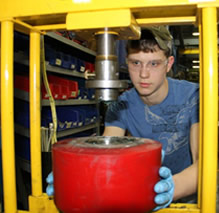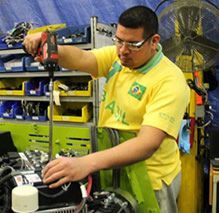If you’re looking for companies who are on top of their safety program, few rise to the level of CLARK Material Handling Company, a manufacturer of forklifts based in Lexington, Kentucky.
CLARK has an impressive history with KEMI when it comes to workplace safety success. For each of the last five years CLARK earned the KEMI Destiny Award, an honor that recognizes KEMI policyholders for their commitment and success in maintaining a safe workplace. CLARK has also received the Governor’s Safety and Health Award several times for their impressive safety accomplishments. In 2015, CLARK worked more than 725,715 hours without a lost-time accident or illness.
We asked April Crosby, Safety Coordinator, and Sherry Myers, Human Resources Manager at CLARK, to share some insight on their forward-thinking approach to workplace safety.
KEMI: Tell us about CLARK Material Handling Company and your impressive history.
April: CLARK Material Handling Company is a forklift manufacturing company based here in Lexington and our company history reaches as far back as 1917 when we were credited with having invented the world’s first truck with a hydraulic lifting mechanism. This truck became the forerunner to today’s modern forklifts, and since our inception CLARK has produced over one million forklifts.
KEMI: Tell us about your role in the organization when it comes to workplace safety.
April: I am the Safety Coordinator at the Lexington manufacturing facility where we have over 140 employees as well as the Louisville distribution center where we employ more than 30. My job is to ensure OSHA standards are being followed and oversee and promote our company’s safety policies. I also assist with lean manufacturing activities such as 5S and other efforts towards continuous improvement here in Lexington and Louisville.
KEMI: How important is safety to your organization?
April: Safety is number one at CLARK. We strive to make sure that all of our employees — whether temporary employees, contractors or actual CLARK employees — are doing things in a safe manner and feel comfortable reporting any concerns whether it is something minor or potentially disastrous.
 KEMI: What aspects of your safety program do you feel are most effective?
KEMI: What aspects of your safety program do you feel are most effective?
April: I believe we have a very good safety committee here at CLARK. Our safety committee is comprised of different levels of employees and we meet a minimum of once a month to discuss issues that have come up throughout the previous few weeks. Our committee also does regular safety audits where we go through all areas of our plants, including the office areas. We have a checklist that we use to help us identify any potential safety-related issues. The committee is also encouraged to look outside of the checklist and ask if the process is really being done in a proper manner. Instead of only relying on my observations as the Safety Coordinator, I think it is a tremendous asset to have an entire team that can take notice of issues or potential hazards and immediately correct the concern or bring it to my attention if necessary. We take a team approach to ensure the safety of everybody here at CLARK and I think that makes a huge difference.
KEMI: What are your biggest safety successes as a company in recent years?
April: Over the past several months, we implemented lean manufacturing principles such as 5S which is basically a system of workplace organization. This system ultimately comes down to good housekeeping, but it has a huge impact on safety. It helps eliminate things that may be lying around and could become trip hazards and helps teach us that everything needs to have its rightful place. We implemented 5S policies and a program where we audit the process on a regular basis, making sure that everybody’s keeping their areas clean and organized.
KEMI: What are your biggest safety challenges moving forward?
April: We are currently going through major construction that will triple our production capacity. We were busting at the seams and filling every little corner that we could. We were working in tight spaces, trying to fit things where they probably didn’t really fit but we didn’t have any other options. Maintaining a safe work environment is definitely challenging in those scenarios, but when you start adding in contractors, who are installing cranes, taking down things, and digging pits, safety becomes an even bigger issue. We have been working hard to ensure that everyone who steps foot in our facility is not only following their safety policies, but ours as well.
KEMI: How do you feel that CLARK benefits from your partnership with KEMI?
April: I think the greatest benefit is that KEMI is concerned about our safety and how we are doing things. The partnership that we have with KEMI is in place to make sure that we keep our employees safe by doing things the way we are supposed to and that we are keeping an open line of communication between CLARK and KEMI. I think that’s really important. It’s not just about what we are doing here internally but KEMI is always available to help our employees and safety committee whenever possible.
Sherry: The customer service is by far better than any other company that we have ever used. When I call, I get to talk to a live person every time. They are always willing to help me resolve workers’ comp and safety-related questions.
KEMI: How do you utilize KEMI’s safety resources?
Sherry: We have used many of the online resources for training, compliance materials, as well as tool box safety talks. One of our most valued resources that KEMI offers is our client services representative, Jeff Floyd. Jeff partnered with us to train our safety committee on how to lead effective investigations, audits, and how to have effective safety meetings. Jeff has provided multiple trainings for us including the OSHA 10-hour training for our safety team.
 KEMI: What is on the horizon for CLARK and how do you see your safety program playing a role?
KEMI: What is on the horizon for CLARK and how do you see your safety program playing a role?
April: Once we start adding in additional manufacturing and assembly processes here in Lexington we will have more employees on site. When it comes to safety, we are going to be stepping up our game to match the increased exposure.
In addition to 5S, we are now developing a 5Y process where any safety issue, concern or accident is automatically followed up with a 5Y set of questions. This will help determine a root cause of an occurrence. The affected employees are learning to ask questions like, “Why did this happen?” and we will try to break it down to find out the root cause of any concern or issue. I think by implementing those questions and by continuing to do the 5Y process, it will help us eliminate problems that have been repeated.
With the addition of multiple people in our production areas, different processes, and different temporary employees, the success of our 5S and 5Y programs as well as the efforts of our safety committee will be important to ensure we are doing everything we can to keep our employees at CLARK safe.
To learn more about CLARK Material Handling Company, visit www.clarkmhc.com.

